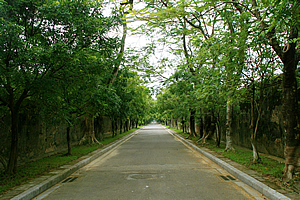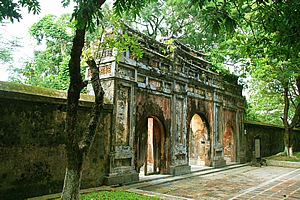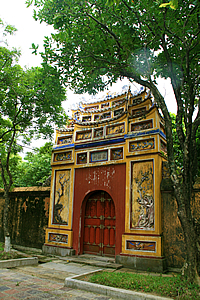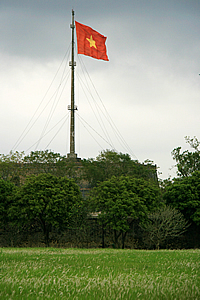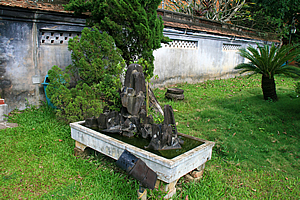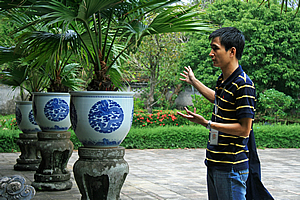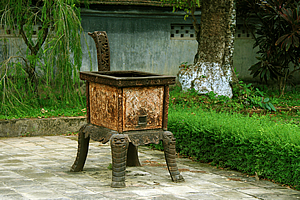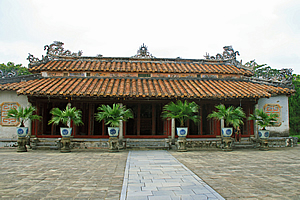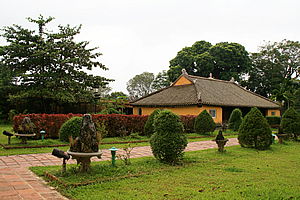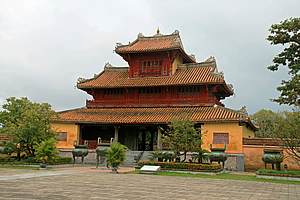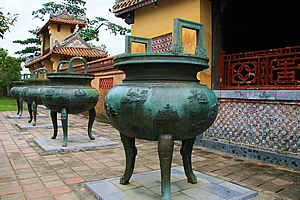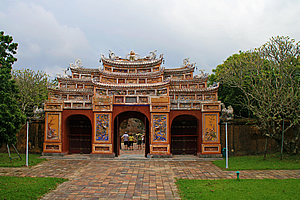--- Archive files ---
Home > Travels > Hue > 3 |
Stone Walls and Large Fields
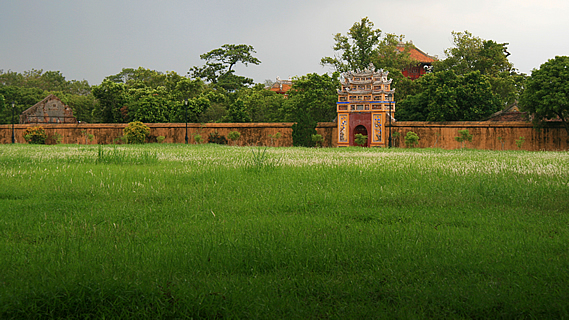
ALTHOUGH much of Vietnam’s Imperial City is still intact after seven decades of abandonment, large areas have succumbed to the decay of time.
Avenue in the Imperial City |
From the inner sanctum of the Forbidden City we passed through a gate in the stone wall heading westward past a fairly small lawn area with squares of very low hedges surrounding flower beds. We passed under another totem to follow a three metre wide paved avenue between fairly young trees. Looking through the trees to our left was a large field of green grass. The grass was unmown and a bit clumpy, but otherwise it was in excellent condition and very lush, certainly not with the scragginess expected from overgrown grass. Large patches of white flowers were sprinkled amongst the grass like snow.
Entrance through the wall |
This field once housed various buildings, but they had long since perished. The French army had bombed most of the city and looted all the treasures from the ruins in 1947. Much of what was left was bombed during the 1968 Tet Offensive in the Vietnam War. The invasion here was so significant that history records the Imperial City as the symbolic epicentre of the Vietnam War.
What was left of the Imperial City, particularly the Forbidden City, was now well looked after and renovated by the locals mainly for tourism, but this field provided a stark reminder that most of the ancient city has been forever lost in the ravages of war.
Closed gate |
Huge flag |
A creamy orange wall surrounded the field, with a couple of fancy pagoda archway gates allowing access to whatever lay beyond. We passed a couple of small market stalls under large colourful umbrellas before we reached an intersection. We continued going straight ahead, but there were now walls on either side under the trees. The path and the walls went a long way ahead of us, visually merging to as far as the eye could see. The shade afforded by the trees allowed moss and other small plants to grow on the walls giving them a much more advanced state of decay than the walls out in the open. They were not at all damaged, but small bits had been eroded from the blocks as vegetation started digging into the cracks in the mortar.
Plants on a rock in a tub |
We walked past a single pagoda gate, with the red arched door closed. The pagoda was brightly coloured yellow, blue and red, and had embossed carvings on the pillars on either side. The small panels holding up each layer of roofing had carvings of birds, dragons and fish.
There was another old stone pagoda in the wall on the other side of the path. This one had three arched entrances and was showing signs of hundreds of years of erosion from the lichens and black moulds sluggishly eating its way into the rock in the hundreds of years since it had been built. We walked through it and saw a similar path passing between trees and decaying walls for about two hundred metres to a very large two storey pagoda.
Palms growing in bowls |
Passing through a simple entrance through the wall to our left led us into an intriguing bonsai garden. There were many low hedges and plants laid out in a random array in amongst large pots containing bonsai trees and interesting marble formations eroded into shapes similar to those I’ve seen on Takaka Hill in New Zealand. Perhaps they have marble formations around here too. I had never seen pots containing eroded marble with bonsai trees growing over the natural form of the sharp rocks.
Urn |
Once through the garden, we passed through another tunnel in a wall to an immaculate garden with a temple directly in front of us. We were approaching the side of it, so the side wall didn’t look like anything special. I knew this would be something pretty amazing though as the roof had the same style carved dragons in it as the palace we had walked through earlier. I could also see a row of huge urn pots out the front.
We walked around to the front of the building. The pots were all in immaculate condition, each with a very healthy young fan palm in it. These pots must be quite recent given they were in such good condition and the plants were only a couple of years old. Each pot was glazed white with elaborate blue glazed circular dragon designs, with the head in the upper middle of the design. The dragon had a very long body with scales clearly showing, and it had designs around it which seemed to represent tiny clouds. Perhaps this was meant to be a dragon in the sky? Each pot was standing on an elaborate tall concrete base that had signs of erosion. The six pots were aligned in perfect symmetry across the front of the building.
Small temple |
We didn’t enter this temple. Maybe there was some kind of cultural taboo to it, or maybe it was under renovations. Anyway there were ropes across the open doors with no entry signs on them. We did get a look inside though. There was little furnishing in there, quite a difference from the other buildings which we had entered which seemed to be a bit too cluttered. The decoration on the walls, ceiling, and columns was absolutely amazing, just like in the palace. Bright reds and oranges were used throughout, although those colours were vastly muted by the lack of natural light getting in. The floor contained square ceramic parquetry of well tessellated simple patterns. I guessed this must be a special meeting hall.
Garden |
After briefly resting here we crossed the stone courtyard. To each side stood a small metal trough on legs, with an unknown purpose. It had a high handle at one end, and a lot of carving all over the container, legs and handle.
Across the other side stood the most elaborate gate entrance I had seen to date. It had three arched entrances, each with a solid timber two way opening door. Only the middle door was open. The roof had four pagoda layers, and it was all carved into the yellow, red and blue painted timber structure.
Temple |
This gate led out to a narrow one metre wide cobblestone path going off in either direction. This path had fancy traditional lamp posts to illuminate it by night. We walked down this path for a couple of minutes before arriving at another garden with large ceramic bowls on crude stone pedestals. These bowls had large eroded marble blocks in them, positioned to the natural erosion. They were sitting in water with small plants growing on them. They were like miniature island rocks, resembling the solemn monoliths of Halong Bay.
Cauldrons |
Passing through another colourful gate, we walked into another huge outdoor room. This one had some very strangely shaped trees growing through some permanent scaffolding like a school jungle gym. The trees had been deliberately misshapen by gardeners wanting to create a strange look to them. Once past these trees, we entered another large paved courtyard. This had a huge three storey pagoda at the far end of it. The near end had a long meeting hall that was mostly closed off and too dark too photograph inside. Like the previous hall we saw, this one had a row of perfectly aligned dragon white and blue glazed pots on big stands with palms in them. This time there were twelve pots all perfectly aligned.
Exit from the city |
There was a large circular cauldron on legs in the middle of the courtyard close to the pagoda. I have no idea what this was used for. It had a ceremonial plaque of brightly coloured panels directly above the bowl. There were another four cauldrons either side without the panels above them.
The pagoda had the most amazing Chinese lanterns I had ever seen. They seemed to be made from precious stones and gold plating. We passed through and down the other side through yet another fancy coloured gate. The stairs had marble rails of carved dragons. Once through the gate, we walked down another avenue of trees with decomposing brick walls on either side of us.
We walked past the large field we had passed on the other side before arriving arrived back at the huge courtyard with the giant flagpole on top of the stone structure. From there we passed through the narrow tunnel entrance back into the chaos of modern Hue.
<< Previous | Next >> |
|
||
About this Page
|
||
|
|
|
Where is Walkabout Jeff? |
|
|
|
|
What is happening in Walkabout Jeff's hometown?
|
|
|
|
|
Who is Walkabout Jeff?Any normal person's idea of going out involves going to the local pub for a drink with a few mates. Walkabout Jeff isn't normal.
|
|
|
|
|
